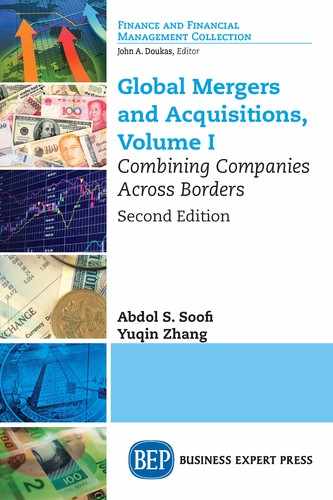Introduction
Reviewing the M&A literature, one comes across a fragmented field of inquiry. One can recognize different patterns in the development of the M&A literature according to the disciplines of the researchers. The research interests in M&A and corporate restructuring literature are primarily concerned with the following questions. Why do companies merge? Are M&As successful in achieving the goals of acquisition and combinations? Why do so many companies fail to create shareholder value or capture the synergies they inspired to gain? How to best value the target firm? What role does postmerger integration play in the postmerger performance of the acquiring and acquired companies? What role do corporate and societal cultures play in the success or failure of M&As? The literature on M&A deals with these and many other questions.
The fragmentary nature of the literature emerges from the discipline-based approach researchers take in answering the questions. One finds articles with emphasis on economics of M&A (economies of scale, market power, and shortcut to obtaining costly technology) written by economists; articles written by strategic management scholars, focusing on motives for acquisition and postmerger performance according to the motives of consolidations; articles written by scholars in corporate finance, concentrating on postmerger performance based on stock market indicators. Studies by researchers on organization theory project attention on postmerger integration and conflicts arising during the integration processes and, finally, experts on human resources have focused on effective communication, cultural differences, and socio-psychological issues that might have an impact on the success or failure of the combined entities. Based on this, it is common knowledge among the scholars of M&As that the discipline-based approach used for answering any of these questions leads to answers that tend to differ and in some cases even contradict each other (Larsson and Finkelstein 1999).
In the first volume of this book, we review the literature of M&A from different angles and bring together valuable, practical insights from this vast literature in a short, but cohesive form that hopefully has great managerial relevance.
Structure of the First Volume of the Book
Cross-border M&As are international activities. To gain a better understanding of the depth and breadth of international business and economic transactions, Chapter 1 deals with globalization or internationalization of economies. In Chapter 2, we define some M&A terminologies, briefly review the motives for M&As, discuss different types of mergers, and differentiate between domestic and cross-border M&As. Chapter 3 gives an overview of M&A processes and reviews problems that often arise during acquisition processes. In Chapter 4, we develop strategies for M&As, define organizational culture, enumerate a set of strategic objectives for M&As, identify the corporate development office as the responsible body in many M&As by several companies, and elaborate on the role of the lead adviser in implementing mergers or acquisitions. Chapter 5 encompasses selecting a potential target for acquisition, enumerates target-screening criteria, and defines as well as lists different types of due diligence.
Chapter 6 discusses accounting for M&As and, using examples, illustrates how the valuation of the target firm will affect the income statement and balance sheet of the combined company. Chapter 7 deals with alternative approaches to valuation of the target firm by illustrative examples of comparable companies approach, the discount cash-flow approach, the capital budgeting method, and free cash-flow calculations under different assumptions about the growth of cash-flows. Chapter 8 examines the critical role the cost of capital plays in valuation methods. Chapter 9 considers real options analysis as a versatile method for valuing target companies in general. Chapter 10 carefully examines how the Black–Scholes model is used in assessing the value of the target companies under different scenarios.
In Chapter 11, we turn our attention to valuing target companies in cross-border M&As, by discussing issues related to international finance. We examine the purchasing power parity theorem and real exchange rate, exchange rate fluctuations, and forward as well as swap currency transactions. Moreover, in the chapter, we discuss the effect of exchange rate fluctuations on the discounted cash-flows of multinational companies.
Chapter 12 discusses the negotiation and deal structuring part of the acquisition process. It focuses on developing a strategy to secure approval from the target firm, refining valuation of the target, and developing a plan for financing the deal. Chapter 13 examines the important topic of postmerger integration and reorganization. Furthermore, the chapter focuses on different types of integrations, approaches to integration, establishing a new organization, integration of functional departments of corporations, and instructs on how to form a new corporate culture.
